Timothy Leary's Endless Party
Artifacts of a public nuisance in Lightspace Gallery's '23 Drawings' by Judith Lewis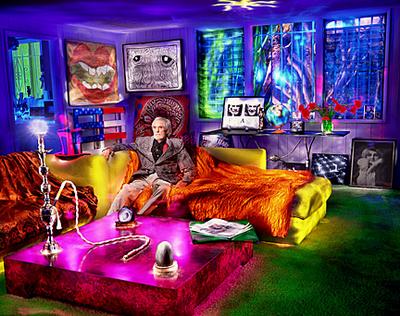
«turn on, tune in, drop out»
Shortly after I arrived in Los Angeles 12 years ago, Timothy Leary called me up and invited me to a party. Fresh from Minnesota and greener than I knew, I was thrilled - "the most dangerous man in America" was just on the phone with me! Then someone I worked with, a mentor and friend I relied upon for professional guidance, warned me not to be flattered. "He's a media whore," he said. "Don't waste your time."
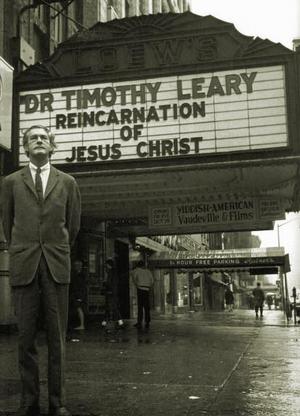
October 1966, at the Village Theater in New York City
A lot of people had similar reactions to Leary while he lived. If you grew up in the '60s and '70s, his name - along with his slogan, "Turn on, tune in, drop out," and Nixon's exaggerated vilifying of him and his crazy, crazy drugs - echoes through your childhood like an overplayed pop song. Researchers exploring psychedelics within the boundaries of the medical establishment found their work frustrated by Leary's news-making shenanigans; even David Gates' affectionate obit in Newsweek acknowledged in its headline Leary's "well-advertised trip". In fact, the perfidious psychonaut was agitating for media time right up until he died: The first (and only) time I talked with Matt Drudge was in 1996, when Drudge broke the news that Leary, terminally ill with prostate cancer, was threatening to Webcast his own suicide.
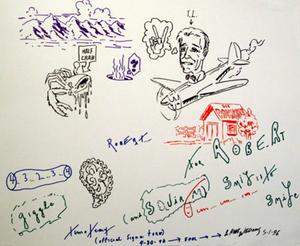
Last month at Light Space Gallery's "23 Drawings by Timothy Leary and Other Works," a show that's been steadily expanding in content since it opened at the end of April, I had a chance to reflect differently on Leary's media whoredom, such as it was. With the gallery's walls now papered nearly solid with Leary memorabilia, the show has turned into a Burroughs-like cut-up of a biography, bits and pieces of a life scattered about without evident organizational sense, but from which the brain miraculously deduces order if the eyes stare at it long enough. Quotes from the man himself are interspersed among missives from others; works of art that bear only an oblique relationship to Leary (Tom Robbins' tripper's version of an alphabet, I Took Acid in the First Grade, for example) augment pieces that could be inspired by no one else (such as Robert Williams' The Milk of Human Kindness: Leary at the Tit).
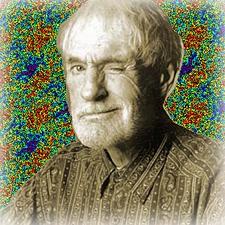
The overall impression is not of a grandstander who narcissistically adored the attention of the media, but of an irrepressible spirit with an unusually exuberant constitution - a man who had discovered, when he first indulged in the mushroom at the ripe age of 40, a source of magic so delightful, so full of possibility, so unreservedly fun that he simply could not keep the news to himself.
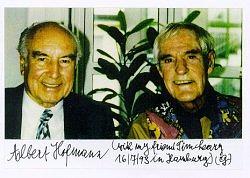
Albert Hofmann and Tim Leary pose in a Hamburg TV studio in 1993
[ Hofmann synthesized LSD in 1938 and again in 1943. He was the first human subject to experience its effect. He later isolated and synthesized psilocybin, the active ingredient of the Psilocybe mexicana mushroom, sacred to the Huichol. ]
Of course he knew it would piss off the authorities. "Anything that's pleasurable is going to bring down the wrath of the power control people," Leary complained. What might have surprised him - it surprises me - is that all his talk about evolution and magic, space and science, and above all the wonders of LSD, mescaline and psilocybin, would arouse the suspicions of other progressive writers and thinkers. "His was the saga of a brilliant academic," writes Dr. Charles Grob in the introduction to his anthology, Hallucinogens, "having discovered a potentially valuable tool for remodeling personality, running headlong into a culture ill-prepared for radical change and increasingly antagonistic to his provocative herald of the New Age." Still, he never gave up. LLate in his life, people who dined with him only casually would take bets on just how long it would take Leary to bring every conversation around to drugs.
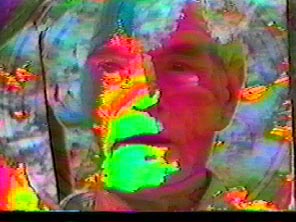
When I first saw "23 Drawings" the night it opened in April, Kenny Scharf's Uncle Timmy's Funbox stood at the center of the room, a diorama of fluorescent paint and toys; a video of Leary at home shot by Chris Graves and Joey Cavella - who helped establish http://www.leary.com/ - was playing near the front window. The room was packed and a little bit wild, and it was hard to spend enough time in front of a piece of drawing or writing to figure out what it was. But on my last visit both of those fixtures were gone, and the room was empty of all people but the gallery's owners, Dean Chamberlain and his wife, Stacy Valis.
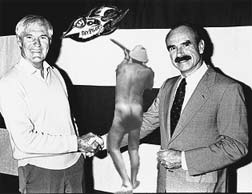
Timothy Leary on the left shaking hands with his old nemesis,
Gordon Liddy. Liddy led the team that busted Leary at Millbrook,
New York. The man in the middle is Hunter Thompson who is
always shooting things down.
Chamberlain had just come back from combing through Leary's archives at Michael Horowitz's house in Marin County, where he'd found a page from Leary's 1937 high school yearbook. Under a classic graduation photo of a clean-cut, jovial teenager is a list of extracurricular activities ("Ring and Pin committee") and scholastic honors five times longer than any other classmate's. Chamberlain affixed the photocopied page to the wall next to a clipping from the school newspaper announcing that Leary had been named editor in chief - not, as one might expect, because of his unique vision as a budding sports reporter, but because of his "consistent punctuality and legibility of copy." Under that the curators had posted a list Leary made at age 10 of things he hoped to accomplish. One of those goals: "Perform some adventure that is original".
"I guess he can check that one off!" said Valis.
Valis and Chamberlain had known Leary only in the three months before he died, when Leary, calling for an end to all "pious, wimpy talk about death," threw what Ralph Metzner described as "a several-months-long going-away party" at his house in Beverly Hills. Mediawise, it was the most redemptive moment of his life: "Having been marginalized all his life for his outrageous views on drugs, or space, or computers, or reality," Metzner wrote in an essay now posted on the gallery wall, "[Leary] had the full attention of the media when he declared, in all seriousness, that he was going to plan his dying to be like a psychedelic session with careful attention to set and setting, and to be a joyous adventure".
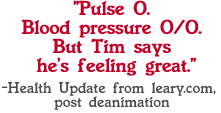
A fifth estate overrun by cynics naturally ridicules anyone who expresses Leary's seemingly uncritical delight over everything new, his obdurate optimism, his all-embracing spirituality. But not even Drudge could make too much fun of a man so determined to revel in humankind's most fearsome moment. That Leary was as giddily enthusiastic about the radical experience of dying somehow dignified him. It shut the critics up.
"If you were a friend of Tim's you became a part of a huge network of Black Sheep," wrote Camilla Grace, of the performance ensemble Retina Logic, in a piece displayed prominently on the gallery's north wall. It was a privilege to be part of that network, but not, I suspect, particularly difficult to get in. While Leary was prone to fits of temper - Chamberlain told me he was kicked out of the circle for a few hours simply for asking whether Leary needed anything - he was also indiscriminating about the people he allowed into his life: He invited everybody to the party. It meant that his social web was massive and eccentric; roughly half the people I know in Los Angeles (and several more in New York and San Francisco) were directly influenced by him in some way - all of them, amazingly, positively". He saw your highest self and you behaved accordingly", Chamberlain told me.
Valis agreed. "You got to see your potential in his eyes", she said.
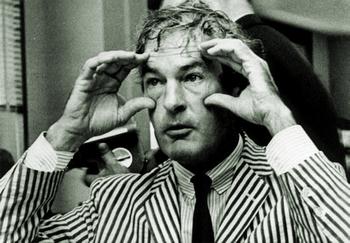
Leary's expansiveness also meant that, even if you declined the invitation, you might find yourself in the network anyway - posthumously, and years later. At the end of my day at Light Space, Valis asked me whether I'd planned to go to a party that evening for a well-known writer and cyber pioneer who happened to be visiting from San Francisco. I told her I wasn't - I didn't know the man very well, I was tired, I had somewhere else to go. But as I left the gallery, I found between the pages of my notebook a sheet of white paper on which Valis had written out directions to the party and the phone number of the house.
I remembered the party I didn't go to so many years ago and decided that the universe had spoken. I changed my plans.

23 DRAWINGS BY TIMOTHY LEARY | AT LIGHT SPACE GALLERY, 1732 Abbot Kinney Blvd., Venice, (310) 301-6969 Through July 31, 2003
Source:
Source:







